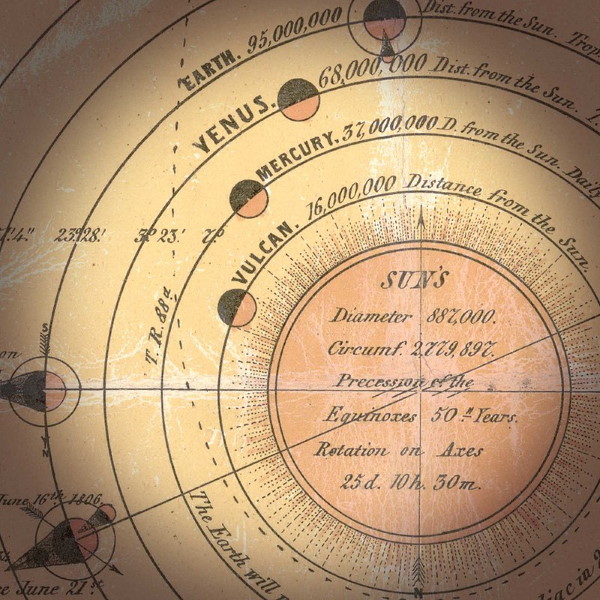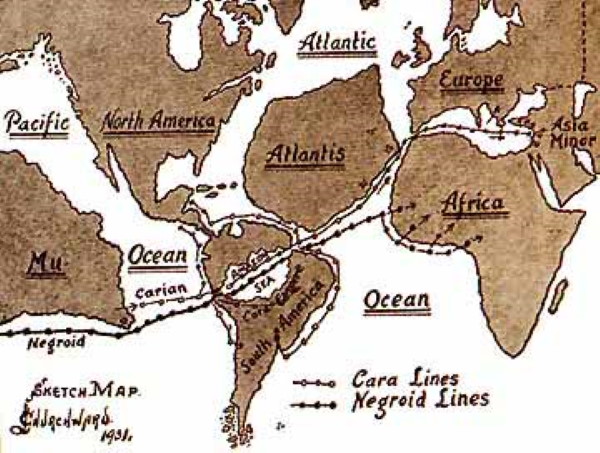Throughout history scientists have expressed crazy theories and, more often than not, they turn out to be exactly that – crazy ideas without any logic or scientific evidence to back them up. But that didn’t stop them being used for hundreds of years before someone told them to stop. While it’s easy to look down on some of these scientific theories and wonder just what the hell they were thinking, hopefully our future generations won’t have the same sentiment when they look back at our breakthroughs and endeavours.
10. Homunculus/Preformationism

Hartsoeker /public domain
<a name=\'more\'></a>
In its simplest form, this is the sperm version of Russian Dolls. Inside a man is sperm which looks like a tiny man, and inside him is a smaller sperm man, and so on and so forth. This theory didn’t just apply to humans but to every living thing, including vegetation. To take it one step further, scientists believed that because all of us were packed into the first load of sperm, all men had existed since the dawn of the universe in the first man, Adam, niftily explaining why we were all born with sin. However, being a spermist didn’t stop just there. It also seemed logical (at least to fellow scientist Paracelsus) that if you were to place human sperm inside a horse womb and feed it blood, you could develop your own tiny-man without the need of a woman. As all features of a baby were believed to come from the father and the mother provided just the womb, it seemed perfectly reasonable that a homunculus would mature in around 40 weeks.
9. Vulcan

Lith. of E. Jones & G.W. Newman – Library of Congress
Keen astronomers will note that the planet Mercury has a different orbit to how it should behave under classical mathematical predictions. As a result, a theory circulated that there had to be a planet between the Sun and Mercury, named Vulcan, which was altering its orbit. Being so close to our shining star where the sky is never dark also explained why it was so hard to see. This wasn’t as far fetched as it might seem because it was believed that the solar system ended at Saturn. Uranus was suddenly discovered, opening up the possibility of more planets. This was proven true when Uranus’ orbit suggested an even bigger planet further out there and clever minds were able to perfectly predict the whereabouts and discovery of Neptune. However, when Einstein published his theory of relativity in 1915, it handily explained all the differences observed in Mercury’s orbit and meant that Vulcan was no longer needed. You might think this discovery would put all questions about Vulcan to rest, but this wasn’t the case. Amateur astronomers still claimed to have ‘found’ Vulcan up to the 1970s, until interest in this planet eventually seemed to fade away. The idea of Vulcan lives on thanks to the efforts of Star Trek writers who created a certain pointy-eared member of the Enterprise who hailed from a planet with the same name.
8. Alchemy

For centuries alchemists tried to create the Philosopher’s Stone – a legendary substance which was believed to contain the elixir of life as well as the ability to transform base metals into noble metals (for example the changing of lead into gold). Scientists dedicated their entire lives to the discovery of this fabled rock. Albertus Magnus even claimed he saw the transformation of rock into gold and legend believed that he possessed the stone, although the evidence of this discovery of immortality is somewhat sketchy due to his untimely death. Now debunked as nothing more than a myth, the seemingly magical properties of the Philosopher’s Stone consumed the minds of some of history’s most prolific scientists. Even Isaac Newton spent more of his time as an alchemist than he did into his physics research, which he treated as no more than a hobby. The study of alchemy did contribute in some ways to modern science, but we can’t help but wonder what else Newton may have advanced had he spent less time on this pseudoscience. However, alchemy shouldn’t be completely mocked. It is entirely possible to create gold from almost thin air. All we need to make this happen is a Large Hadron Collider to smash atoms together with incredible power, generating microscopic amounts of gold. The energy used may far, far outweigh the worth of gold produced, but no one said we had to be practical.
7. Humorism

Humorism is a theory which postulates that the human body is made up of four humors; black bile, yellow bile, phlegm and blood. When there is an imbalance, we become ill or suffer from disabilities if they are not treated with haste. The most well known form of humorism is bloodletting, primarily due to physicians believing blood was often the most imbalanced of all humors. As the name suggests, this is the removal of blood to cure or prevent illness, most often by leeches. When it came to how much blood had to be removed, they often waited until the patient fainted as this was a sign that their humors were in balance (and the leeches well fed). It was accepted that almost everything ranging from acne and indigestion to cancer and insanity could be cured due to the imbalance of blood. George Washington had close to 4 litres of blood removed via leeches to cure a sore throat. It didn’t help much as he died several hours later. Humorism was the standard care of practice in Ancient Greece, and it was slowly adopted by the Roman Empire before making its way to Islamic doctors. Whilst this may seem like a very outdated form of medicine, the astounding truth is that this was the primary form of care until the 19th Century when modern medicine began to disprove its usefulness. Granted, there are a few rare cases where bloodletting is a recognised form of treatment (such as high blood pressure), but let’s not go reaching for the leeches just yet.
6. Tobacco

Tobacco has long been used throughout history as a form of trade or to seal a deal through the smoking of a peace pipe. Although one would think that inhaling smoke was a not a good thing, this idea wasn’t accepted by mainstream public until the mid 60s, and it only gathered real steam almost two decades later. With the backing of famous adverts like “’more doctors smoke Camels than any other cigarette!”, physicians would often prescribe the use of tobacco to cure a variety of ailments such as asthma and as aides in weight loss. Perhaps one of the most bizarre health claims of cigarettes was the advisement which claimed pregnant women should smoke as they would give birth to smaller babies. Whilst a smaller size may help in childbirth, in hindsight we now know the pain of a wide birth canal far outweighs the negative effects of smoking during pregnancy. Although it was known that cigarette smoking did cause some problems such as throat irritation, it was stated that this only affected some people, usually those of a sensitive disposition. Instead of not recommending smoking at all, doctors were instead advising to use a different version of cigarettes (such as Lucky Strikes) which were marketed as less irritating to tender throats. Add this together with tobacco enemas and tobacco toothpaste and you might just wonder what health professionals were really smoking back then.
5. Radiation is good for you

It’s hard to believe there was once a time when scientists believed radiation was actually good for you, yet this was true during the early 20th century. As a direct result of this misguided belief, there were many popular radioactive products that were actively marketed as being good for the health, even curing such ailments as arthritis and rheumatism. These ranged from ingesting radioactive water, brushing your teeth with radioactive toothpaste thought to make your teeth shine and sparkle, to even lying down in uranium rich sand to sooth those annoying aches and pains. This practice continued well into the 1950s, with perhaps the most famous case being the Radium Girls. These factory workers were challenged with the task of painting watch dials with radioactive paint to make them glow in the dark. They didn’t just stop there; they would often paint their nails and teeth for fun. As we would now expect, many died or suffered from anemia or necrosis of the jaw, commonly known as radium jaw. One of the outspoken supporters of the safety of radiation was Nobel Prize winner Marie Curie. With her refusal to accept the dangers of radiation, Curie suffered from many chronic illnesses including near blindness induced by cataracts. Due to years of storing test-tubes wherever she felt, often in her coat pocket or desk drawer, her notebooks (and even cookbook) have such high levels of radiation they are considered too dangerous to handle and are stored in lead lined boxes. Nowadays it’s probably for the best that we stick to radiation free glow sticks for our glow-in-the-dark needs.
4. Mercury as a laxative

Despite being insanely toxic and requiring special handling, mercury was once used by scientists in a variety of very different ways. In the early 20th century mercury was often administered regularly as a laxative and dewormer for children as well as being used as an active ingredient in teething powders for young infants. Additionally, traditional medicine saw it being used for all conditions ranging from constipation and toothaches to depression and child-bearing. One of its most famous medical applications is the use of mercury in treating syphilis, which actually does help fight the disease. This is because one of the side effects of being dosed by mercury is a high fever, which syphilis is highly sensitive to. However, mercury poisoning also has the added bonus of frequently causing insanity and death, not dissimilar to the disease it was often used to treat. So before you crack open the thermometer as a home remedy, maybe seek a professional’s opinion first.
3. World Ice Theory (Welteislehre)
In 1984 Hanns Horbiger proposed a concept in which all substances in the cosmos came from ice. Ice moons, ice planets and everything ice in between. Unlike most scientists on this list who were perhaps lacking in evidence to disprove them otherwise, Hanns came to this theory with no research, but through a vision. His dream immediately discredited Newton’s Law of Gravity (according to Hans at least). He worked with amateur astronomers to flesh out his theory before happily publishing his ideas. According to the theory, the solar system began when two stars collided. The impact of this caused fragments of the smaller, wetter star to be blasted out into space where it froze into giant blocks of ice; forming what we now know as the Milky Way as well as a bunch of other solar systems. The planets were formed when large chunks of ice collided with each other whilst the smaller blocks are what we know as meteors. When these collide with the Earth, they produce hailstorms. As suspected, academics paid little attention at first to his theory. Nevertheless, a segment of the general public actually began supporting his ideas in such strength that societies were founded, pamphlets were handed out and even a newspaper was published. Strangely enough, it began to spread into politics. Adolf Hitler was a firm believer and even adopted this theory as the Nazi Party’s official cosmological belief. After the end of World War II, this theory pretty much lost any support it once had. But be warned, there is still a small cult of followers out there, trying to melt away all scientific evidence which could leave their beliefs out in the cold.
2. Germ Theory

We all know the importance of washing our hands before preparing food, and we know that this simple task is also very important when it comes to performing surgery. This wasn’t always the case. Once upon a time the common belief amongst doctors and surgeons was that a gentleman’s hands were always clean, thus did not need to be washed. As you can probably guess, mortality rate was quite high. Ignaz Semmelweis, a Hungarian physician, noticed that when it came to birthing, two hospitals had very different death rates. The hospital for the poor, and therefore staffed by midwives, had far fewer cases of puerperal fever than the hospital staffed by the best doctors around. This seemed completely against common sense as the physicians were presumed to better trained than the midwives. He noticed that the physicians were doing autopsies on women who had died during childbirth with puerperal fever and then heading over to the operating room to deliver babies. Semmelweis concluded that the doctors were somehow poisoning the women, and at first he believed it was due to some sort of toxic chemical (we now know as germs). He concluded that the best way to prevent this was by washing the ‘toxin’ off. His theory paid off and mortality rates in the hospitals dropped to nearly the same rate (and also proved the midwives were just as effective as delivering babies as the doctors!). Although this should have made him into a well published scientist, his career didn’t quite go as planned. His ideas were rejected by the medical community when he could offer no acceptable evidence or explanation, and they weren’t excited to be told their hands were in need of a cleaning. His eventual breakdown had him committed into an insane asylum for the remainder of his life.
1. Lost Lands

Lost lands were believed to be continents, islands and regions which supposedly existed during the prehistoric era. It was thought that they had disappeared due to either a huge devastating geological event or because of the rising water level of the Ice Age. Although this now seems like the stuff of legend comparable to the fabled lost city of Atlantis, up until the late 1950s this was the central belief of scientists. When faced with similar fossils which had appeared thousands of miles across oceans, the easiest way to solve the reason for this distance was to draw a sunken bridge between the appropriate land masses on a map. At least six of these bridges were accepted as fact, all of which have since became obsolete and disproved. Alfred Wegener was among the first to observe how the different land masses of the Earth seemed to fit together like giant puzzle pieces, giving birth to the theory of Continental Drift. Whilst he attracted few supporters, his ideas were largely met with criticism and skepticism due to the top geologists being resistant to change and his lack of reason as to why the land masses had moved. The missing evidence he needed was tectonic plates. Like all good discoveries, these were found largely by accident. With the new invention of sonar, submarines during World War II spent a huge amount of time scouring the ocean depths, clearly showing the many plate boundaries. Although Wegener didn’t live long enough to see his theory became widely accepted, we’re sure he’d consider all their disagreements as water under the bridge by now.
https://archive.janatna.com/
 Hartsoeker /public domain
Hartsoeker /public domain  Lith. of E. Jones & G.W. Newman – Library of Congress
Lith. of E. Jones & G.W. Newman – Library of Congress 







